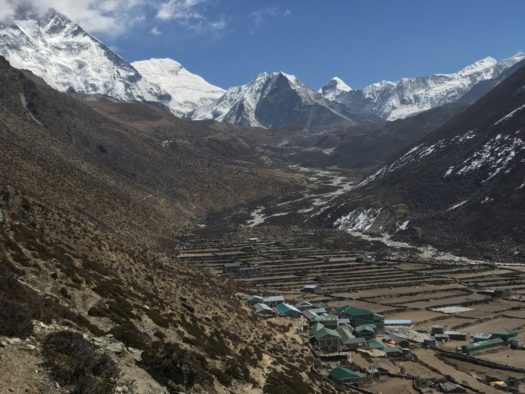Altitude in Nepal Trekking: Blessing and Challenge
Trekking in Nepal: Dealing with the Altitude
06.03.2018

One of the many things that sets Nepal trekking apart from so many other hiking adventures is the elevation above sea level. Obviously, this contributes to the adventure, but it also comes with risk. It’s a risk we all face and can all work together to prepare for and deal with.
According to the Centers for Disease Control, Acute Mountain Sickness (AMS) is the most common form of altitude illness, affecting roughly 25% of all visitors sleeping above 8,000 ft (2,500 m). The cause is essentially the body’s reaction to there being less oxygen in the air. Symptoms are those of an alcohol hangover: headache is the primary symptom, sometimes accompanied by fatigue, difficulty sleeping, loss of appetite, nausea, and occasionally vomiting.
Nearly everyone could experience some symptoms of AMS on a trek to Mt. Everest Base Camp, especially above the village of Namche Bazaar at about 11,250’. In fact, your fitness level or prior experience in trekking at altitude has little to do with whether you will experience symptoms of AMS: novices have been known to experience few symptoms, whereas experienced trekkers and highly-conditioned athletes are sometimes significantly affected.

Preparing for the Altitude
There is really no way to train for the effects of altitude. If you live in an area where you can get to a high elevation, that could be helpful, but you would have to spend a week or more for your body to fully adjust, and even then you will probably lose the effect well before your trip to Nepal. Also, your reaction to high altitude conditions one time doesn’t necessarily dictate your reaction the next time.
Once in Nepal, however, it’s very important you take some basic precautions:
- Ascend at a reasonable pace, which all of our trips are designed to do
- Follow the basic rule of “hike high, sleep low.” We accomplish this with day hikes on our rest days, like at Namche when we visit the Everest View Hotel.
- Drink plenty of water; four liters per day is recommended. This is the number one thing to do.
- Eat full meals, even if you’re not feeling hungry.
- Get plenty of rest
- Familiarize yourself with the symptoms and tell a guide if you experience any of them.
Medication
Diamox is a common medication to prevent symptoms of AMS. Some doctors recommend starting diamox the day before you go to high elevation, then tapering off after you’ve gotten there. Others say to keep taking it until you descend. Yet others say to wait until you begin to feel the effect of high altitude before you start diamox.
Diamox, taken properly, can be of great help; like any medication, it can also have side effects. The most common side effects we see are a metallic taste in the mouth, tingling in toes and fingers, and increased urination.
Whether to take diamox is a personal decision you and your doctor, and/or a travel health specialist, should make together.
When Symptoms Occur
We want to emphasize that it is common to experience mild forms of AMS and nevertheless continue ascending, after allowing additional time to acclimatize. If you start to feel sick, tell your guides immediately. The best response is to rest in place and descend to a lower elevation if symptoms don’t lessen. Often, this will result in your feeling better, getting better acclimatized, and being able to continue your trek.
Risks of AMS
Aside from feeling poor and possibly having your trek delayed or even ended prematurely, AMS — if it isn’t treated promptly and appropriately — can lead to much worse conditions like high altitude cerebral edema (swelling of the brain) or high altitude pulmonary edema (fluid accumulation in the lungs. Both of these conditions can be fatal if untreated, and in both cases the only realistic treatment is rapid descent. In the Khumbu region of Nepal, this often means calling for a helicopter to a Kathmandu hospital.



